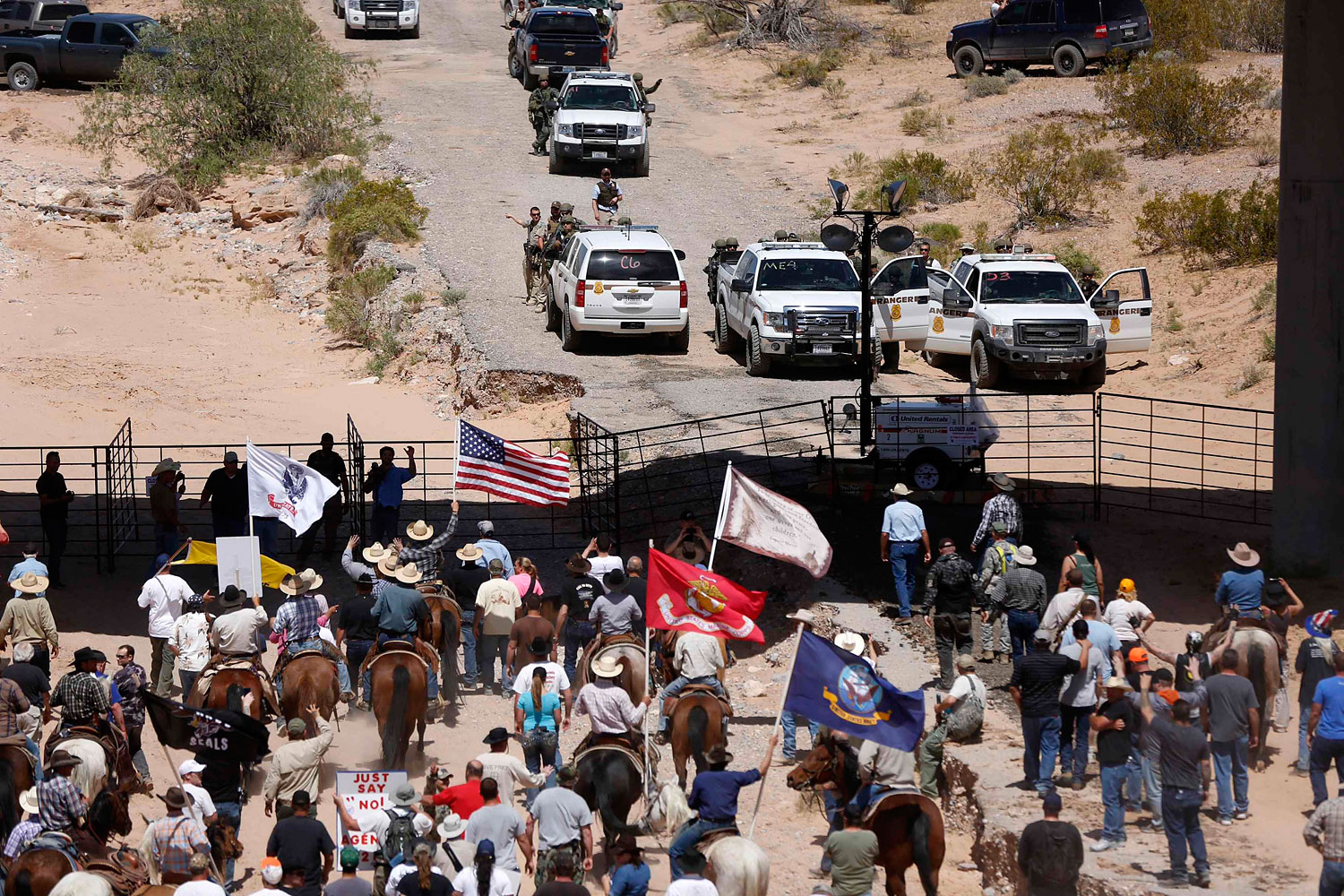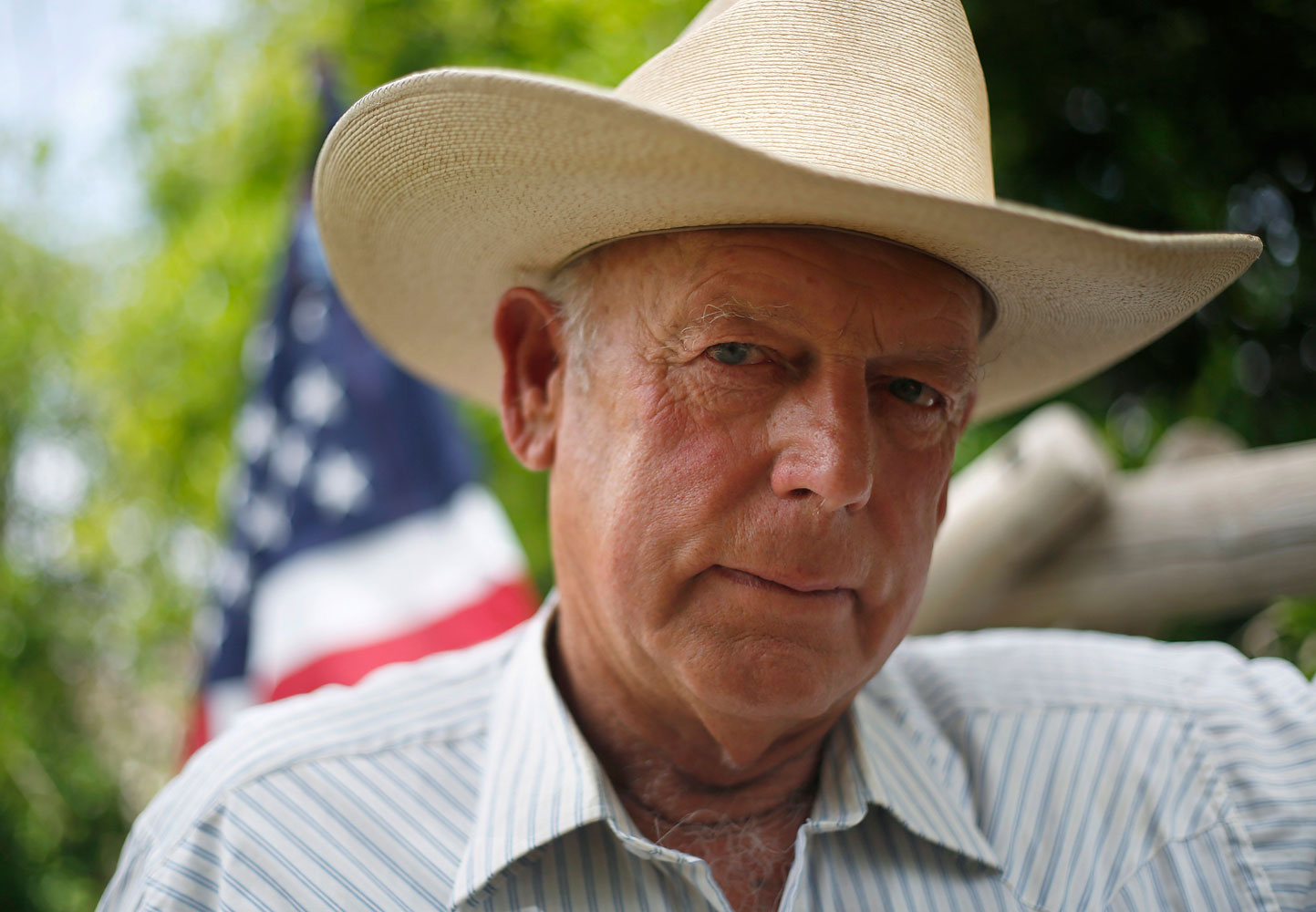
It could have been a catastrophe. For several days last week, hundreds of angry protesters faced off with federal workers on an arid ranch near Bunkerville, Nev. Militiamen squatted among the sagebrush and crouched on a highway overpass, cradling guns and issuing barely veiled threats at the government officials massed behind makeshift barricades. The specter of a violent standoff hung over the high desert.
The hair-trigger tension seemed at odds with the arcane origins of the dispute. Twenty years ago, the U.S. Bureau of Land Management (BLM) decided to clear privately owned cattle off this patch of public land to protect the endangered Mojave Desert tortoise. Dozens of ranchers left. Cliven Bundy stayed.

Bundy, 68, has refused to recognize federal authority over the land, or to pay the feds for allowing his cattle to graze there. Those accumulated fees and fines now total more than $1 million, according to the government. Armed with fresh court orders, the government moved last week to impound a few hundred of the rancher’s cows.
Bundy balked, and the far right-wing media sounded a clarion call for his cause, casting the standoff as a flashpoint in a broader struggle against federal oppression. A cavalry of patriots arrived, bearing weapons and a seemingly bottomless grudge against the government.
On April 12, BLM retreated, abandoning the round-up amid “serious concerns” over the safety of federal employees. The cattle “gather is over,” BLM spokesman Craig Leff says. No shots were fired; no blood was spilled. Bundy declared victory in the Battle of Bunkerville. His supporters festooned a nearby bridge with a hand-lettered sign reading: “The West Has Now Been Won!”
For the government, it is not yet clear what was lost. The decision to de-escalate the situation was a wise one, according to officials familiar with the perils posed by such confrontation. “There was no need to have a Ruby Ridge,” says Patrick Shea, a Utah lawyer and former national director of BLM, invoking the bloody 1992 siege at a remote Idaho cabin, which became a rallying cry for the far right. Shea praises BLM’s new director, Neil Kornze, for defusing the conflict and skirting the specter of violence. There are plenty of ways for the government to recoup the money Bundy owes, Shea says, from placing liens on his property to collecting proceeds when the cattle go to slaughter. When you have been waiting a generation to resolve a dispute, what’s another few weeks?
But prudence may also set a dangerous precedent. Having backed down from one recalcitrant rancher, what does BLM do the next time another refuses to abide by the law? “After 20 years and multiple court orders to remove the trespass cattle, Mr. Bundy owes the American taxpayers in excess of $1 million,” Kornze said in a statement. “The bureau will continue to work to resolve the matter administratively and judicially.” A BLM spokesman would not say what those remedies might be, and declined to make officials available to explain how the agency may treat similar situations in the future.
The government’s legal case against Bundy is strong. It has been winning courtroom battles against the rancher since 1998, and over the past two years has obtained court orders requiring Bundy to remove his cattle from public lands. This month’s roundup was a long-threatened last resort, and Bundy’s success in spurning it could spark copycat rebellions.
“I’m very concerned about that, as I’m sure others are,” says Bob Abbey, a former BLM director and state director for Nevada. Nearly all ranchers whose animals graze on public land are in compliance with federal statutes, Abbey says. But “there always is a chance that someone else may look at what happened with Mr. Bundy and decided to take a similar route.”
Especially since Bundy has become something of a folk hero for people who resent federal control of the old American frontier. The BLM manages more than 245 million acres of land, including about 60% of the territory across a swath of 12 Western states. About 85% of the land in Nevada is managed by the feds.
Bundy, whose ancestors have inhabited the disputed land since the 19th century, rejects this arrangement. The rancher, whose family did not respond to multiple interview requests from TIME, says he does not recognize federal authority over Nevada’s public land. “I abide by all state laws,” he said in a recent interview with the Los Angeles Times. “But I abide by almost zero federal laws.” He has warned that the impoundment of his cattle would spark a “range war,” and said in a court deposition that he would attempt to block a federal incursion, using “whatever it takes.”
Likeminded libertarians in the West have resurrected the spirit of the so-called Sagebrush Rebellion, a 1970s-era movement to transfer control of federal lands to the states. Demar Dahl, an Elko County, Nev., commissioner and longtime friend of Bundy, says the rancher is willing to pay the back fees he owes (though both dispute the amount) to the county or to the state, but not the federal government. “He says the federal government doesn’t have the authority to collect the fees,” Dahl says. “You can call him bullheaded. He’s a strong and moral person. He decides what needs to be done and how, and where he stands.”
To Bundy’s supporters, the legal proceedings are nothing but a land grab. And some of them believe government invoked the protection of the desert tortoise as a pretext. This line of thinking holds that Nevada Senator Harry Reid, the Democratic leader whose former aide, Kornze, now runs the BLM, wants to requisition the land so that his son and Chinese investors can build a lucrative solar farm. At the same time, the left sees in the resistance the ubiquitous hand of the Koch brothers, whose main political outfit, Americans for Prosperity, has rallied support for Bundy.
While the protesters have mostly dispersed, the standoff “isn’t over,” Reid declared Monday. And local officials know just how close they crept to a cataclysmic incident. “That was as close to a catastrophe as I think we’re ever going to see happen,” Dahl says.
The high drama seemed to stoke a sense of theatrics in the protesters. At a press conference on April 14, they invoked battles against the British and shouted quotes from the Scottish revolutionary William Wallace, memorialized in the Hollywood blockbuster Braveheart. The men who rode to Bundy’s defense got to play the hero in the movies of their minds; the threat is that the next climax doesn’t have a peaceful ending.
Bundy “would probably rather be a martyr than a profitable rancher,” says Shea, the former BLM director. “Eventually, you have to draw the line. We go through these sad episodes where fanaticism has to be brought under legal control. And inevitably, somebody is killed.”
More Must-Reads from TIME
- L.A. Fires Show Reality of 1.5°C of Warming
- Home Losses From L.A. Fires Hasten ‘An Uninsurable Future’
- The Women Refusing to Participate in Trump’s Economy
- Bad Bunny On Heartbreak and New Album
- How to Dress Warmly for Cold Weather
- We’re Lucky to Have Been Alive in the Age of David Lynch
- The Motivational Trick That Makes You Exercise Harder
- Column: No One Won The War in Gaza
Write to Alex Altman at alex_altman@timemagazine.com



